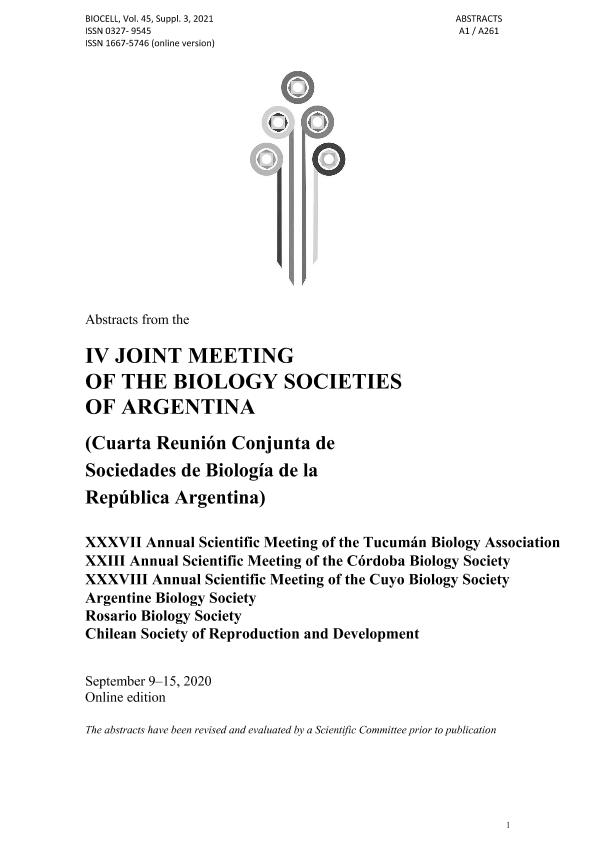Mostrar el registro sencillo del ítem
dc.contributor.author
Diana, A.
dc.contributor.author
Buttazzoni, A.
dc.contributor.author
Sosa, M. A.
dc.contributor.author
Vieira, L.
dc.contributor.author
Aguilera, Andrea Carolina

dc.date.available
2022-11-16T19:12:46Z
dc.date.issued
2021
dc.identifier.citation
Changes in n-acetyglucosamine content associated with capacitation and chemotaix in porcine spermatozoa; IV Joint Meeting of the Biology Societies of Argentina; Mendoza; Argentina; 2020; 28-28
dc.identifier.issn
0327-9545
dc.identifier.uri
http://hdl.handle.net/11336/178072
dc.description.abstract
In mammals, only a small number of ejaculated spermatozoa (SPZ) reach the region of the oviduct (ampulla) after the copula, where they encounterand fertilize the egg. It has been suggested that a sperm subpopulation is selected during their transit trough the female genital tract, so that only thosewith high fertilizing capability and the best skills for supporting embryo development can fertilize the egg. Fluids of the female genital tract, such asthe follicular (FF), the oviductal fluid (OF), and the secretion of cumulus-oocyte complex (COCs), could promote the SPZ chemotaxis to thefertilization site. Progesterone (P4) is considered as an effective chemoattractant in most mammalian species, though other components of the fluidscould attract SPZ even more efficiently. In the present study, we evaluated possible changes in carbohydrate composition of sperm surface aftercapacitation and chemotaxis. For this, we determined the content of N-acetyl-glucosamine (NAG) in porcine SPZ after the mentioned processes byusing WGA-FITC lectin and flow cytometry. We observed that NAG content was significantly higher in the capacitated SPZ (30 min in capacitationmedia TALP, at 38.5ºC and with 5% CO2) compared to fresh SPZ or SPZ stored in BTS (diluent media). For the chemotaxis assays, OF and FFcollected from prepubertal gilts (OF0 and FF0) and periovulatory phase (OF2 and FF2) were used as chemoattractants. Six wells were filled withfresh spermatozoa (20×106/mL) from fertile boars (N = 3) selected in a discontinuous percoll gradient and immediately transferred to TALP,previously equilibrated at 38.5ºC and 5% CO2. The opposite wells of the chemotaxis chamber (six) were filled with TALP (control group) or TALPsupplemented with the chemoattractants as indicated: (1) TALP (control), (2) FF0 (1.25%), (3) FF2 (1.25%), (4) OF0 (1.25%), (5) OF2 (1.25%), (6)P4 (28.3 pM). After 20 min at 38.5ºC and 5% CO2, the SPZ from the opposite wells were rescued, processed for NAG detection and analyzed byflow cytometry. We observed that NAG content was significantly lower in the SPZ obtained from the groups 3 and 6 compared to the control groupor the original SPZ (P < 0.05). These preliminary results suggest that FF2 and P4 can selectively attract a SPZ subpopulation with low content ofNAG in the plasma membrane under the in-vitro conditions.
dc.format
application/pdf
dc.language.iso
eng
dc.publisher
Tech Science Press

dc.rights
info:eu-repo/semantics/openAccess
dc.rights.uri
https://creativecommons.org/licenses/by/2.5/ar/
dc.subject
N-ACETYL-GLUCOSAMINE
dc.subject
SPERMATOZOA
dc.subject
PORCINE
dc.subject
CAPACITATION
dc.subject.classification
Bioquímica y Biología Molecular

dc.subject.classification
Ciencias Biológicas

dc.subject.classification
CIENCIAS NATURALES Y EXACTAS

dc.title
Changes in n-acetyglucosamine content associated with capacitation and chemotaix in porcine spermatozoa
dc.type
info:eu-repo/semantics/publishedVersion
dc.type
info:eu-repo/semantics/conferenceObject
dc.type
info:ar-repo/semantics/documento de conferencia
dc.date.updated
2022-09-14T16:05:32Z
dc.identifier.eissn
1667-5746
dc.journal.volume
45
dc.journal.number
3
dc.journal.pagination
28-28
dc.journal.pais
Estados Unidos

dc.journal.ciudad
Henderson
dc.description.fil
Fil: Diana, A.. Universidad de Murcia; España
dc.description.fil
Fil: Buttazzoni, A.. Universidad Nacional de Cuyo. Facultad de Ciencias Exactas y Naturales; Argentina
dc.description.fil
Fil: Sosa, M. A.. Universidad Nacional de Cuyo. Facultad de Ciencias Exactas y Naturales; Argentina
dc.description.fil
Fil: Vieira, L.. Universidad de Murcia; España
dc.description.fil
Fil: Aguilera, Andrea Carolina. Consejo Nacional de Investigaciones Científicas y Técnicas. Centro Científico Tecnológico Conicet - Mendoza; Argentina. Universidad Nacional de Cuyo. Facultad de Ciencias Exactas y Naturales; Argentina
dc.relation.alternativeid
info:eu-repo/semantics/altIdentifier/url/https://sbcuyo.org.ar/wp-content/uploads/2021/08/BIOCELL-Vol_-45-Suppl_-3-2021.pdf
dc.conicet.rol
Autor

dc.conicet.rol
Autor

dc.conicet.rol
Autor

dc.conicet.rol
Autor

dc.conicet.rol
Autor

dc.coverage
Internacional
dc.type.subtype
Reunión
dc.description.nombreEvento
IV Joint Meeting of the Biology Societies of Argentina
dc.date.evento
2020-09-09
dc.description.ciudadEvento
Mendoza
dc.description.paisEvento
Argentina

dc.type.publicacion
Journal
dc.description.institucionOrganizadora
Sociedad de Biología de Cuyo
dc.source.revista
Biocell

dc.date.eventoHasta
2020-09-15
dc.type
Reunión
Archivos asociados
